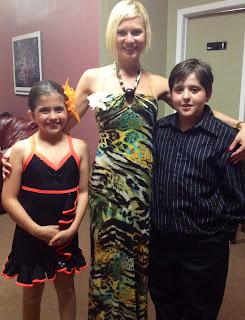~by Nancy LaPierre
(Adapted from the letter ‘He Danced His Way from
Disability to Ability’ by Victoria Marin)
“Ballroom dancing proved to be the ideal activity for my child. It provided the opportunity to develop social
and communication skills as well as more fluid and coordinated movements . . .
. . a sense of self awareness as well as self esteem.” ~ Victoria Marin, mother
of Aiden and author of Aiden’s Waltz
Autism rates have shot up 78% in the last decade, announces
CNN’s headline, a disturbing footnote to March’s report by the Center for
Disease Control and Prevention that 1 of every 88 American children is now affected
by the disorder.
Therefore, Victoria Marin, a dedicated Fred Astaire
dance student at the Westwood, New
Jersey
Marin, who holds a degree in Occupational Therapy and
is the mother of five children, published this chronicle of her “out of the box
approach to raising a child with special needs” in February this year. “These
misunderstood children have suffered from difficulty in making friends and
handling relationships with peers,” she wrote in her recent letter to us. Aiden’s
mother is amazed by just how far her son has come through his dancing journey. From a boy who used to do nothing but watch as
other children played soccer, she reports, “Aiden rose from the shackles of
autism to dance with the grace and elegance of a swan across the ballroom dance
floor.”
Marin is convinced of the benefits of ballroom dance,
especially when it comes to helping kids like Aiden, who are, her book teaches,
“like every other child who needs love, care and respect.” She credits ballroom dance with “a holistic
approach to dealing with the challenges of autism,” and attests that the
benefits to Aiden have been multi-dimensional and inspiring, reflecting physical,
social, emotional and cognitive growth.
Prior to his dance lessons, she says, Aiden, like
other autistic children, experienced great difficulty with recreational
activities, such as being on a sports team and any other situations where
initiating and maintaining peer relationships is necessary. However, through dance, “my son’s
communication skills developed to where he could initiate a conversation with
his dance partner. After continued
participation, his communication skills blossomed to where he could approach
other dancers and ask them to dance.”
Autistic students gain confidence in themselves and
others through ballroom dance, for it requires that “the child learns to let go
of their fears and anxieties and trust the movements of their partner,” Marin
explains. The constant contact with a
partner it demands also helps overcome the distrust of physical closeness that often
comes with autism. “In addition to learning the steps,” she explains, “dancing
requires the participants to respect physical boundaries, maintain position and
posturing and conform to the social rules of the ballroom,” all lessons that strengthen
areas of weakness most autistic children face.
“Another fascinating component to ballroom dancing is
the classical music,” she reports. “New
research has noted the role of music in facilitating self-expression,
creativity and sociability in children.
Classical music appears to reduce stress while increasing the ability to
concentrate. Muscle tone relaxes and the
heart rate slows which causes the mind to be receptive to learning. A positive outlook or increased self esteem
often leads to improvements in the creative thinking process.” And, she adds, the
effect classical music has on the anatomy of the ear actually “stimulates brain
activity.”
“The dance can be viewed as a dynamic conversation
between partners where eye contact is necessary, external sensory stimuli is
processed, gross and fine motor movements are coordinated and a relationship
between partners is developed,” says Marin. To her great joy, Aiden overcame
the seemingly-insurmountable hurdles autism erects in each of these areas
through learning ballroom dance.
“In my experience, ballroom dancing helped my son to
emerge as a young boy who no longer felt ‘different’ from the other
children. The world of ballroom dancing
opened the door to a fresh and innovative sport. Aiden beamed with self confidence which he
gained from being a leading partner on the dance floor. In time, his coordination improved which
helped build his self esteem.”
“While Aiden still is not considered a social butterfly,”
she adds, “his beautiful ocean blue eyes look right at you when he speaks,” a directness
that autism usually inhibits. “Ballroom dancing provided the necessary tools
for my son to emerge from his own darkness and dance before the entire student
body.”
Marin’s experience has made her faith in ballroom
dance unshakeable: “Given the support
and opportunities,” she now knows, “all individuals with special needs possess
talents as well as the ability to achieve!”
Thank you to
Renata Sowul, Manager at FADS Westwood ,
N.J.



2 comments:
Great article. God bless you.
nice place to have dance lessons.
Post a Comment